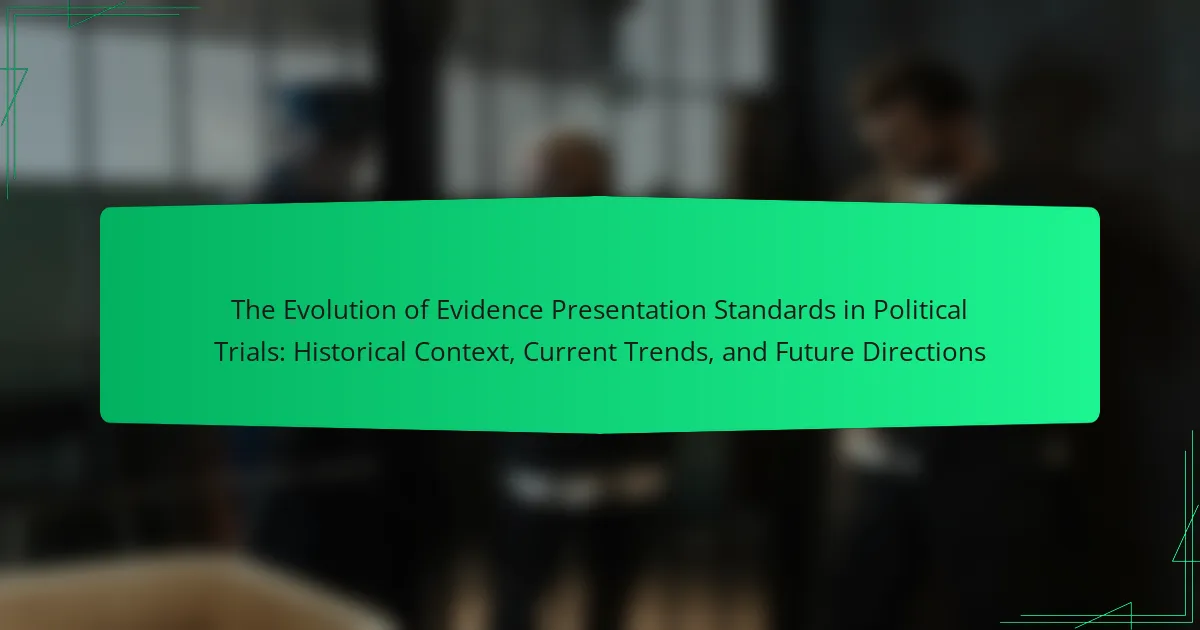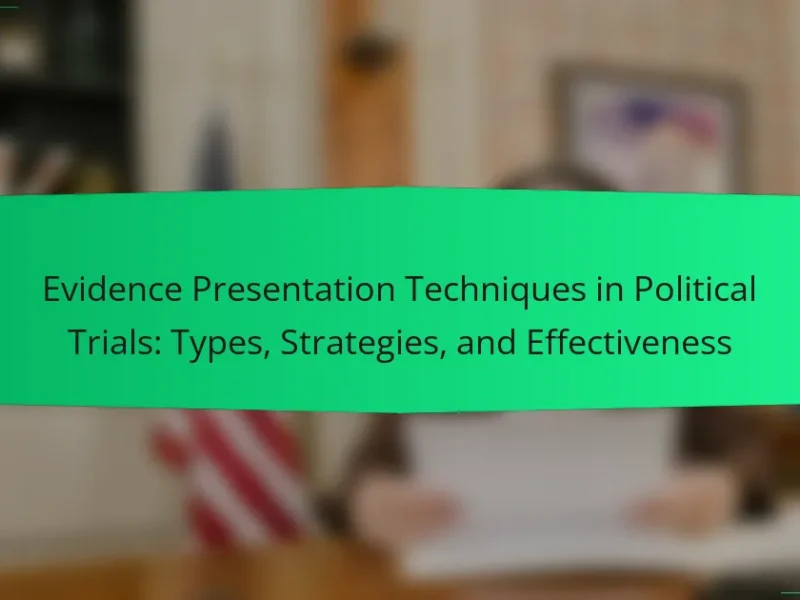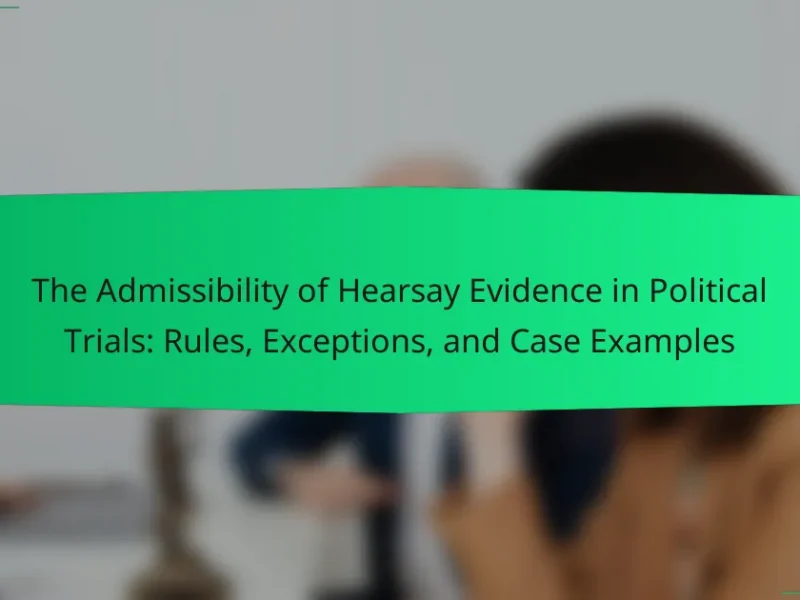The article examines the evolution of evidence presentation standards in political trials, focusing on their historical context, current trends, and future directions. Key concepts include relevance, admissibility, and reliability of evidence, which are essential for maintaining the integrity of the judicial process. The article highlights the influence of established legal frameworks, such as the Federal Rules of Evidence, and discusses the heightened scrutiny in political trials due to public interest. Current trends emphasize clarity, accessibility, and the integration of technology, with a growing use of multimedia and interactive presentations to enhance jury comprehension. Looking ahead, the article anticipates a shift towards digital formats and advanced data visualization techniques, alongside necessary adaptations in legal frameworks to address the challenges posed by digital evidence.
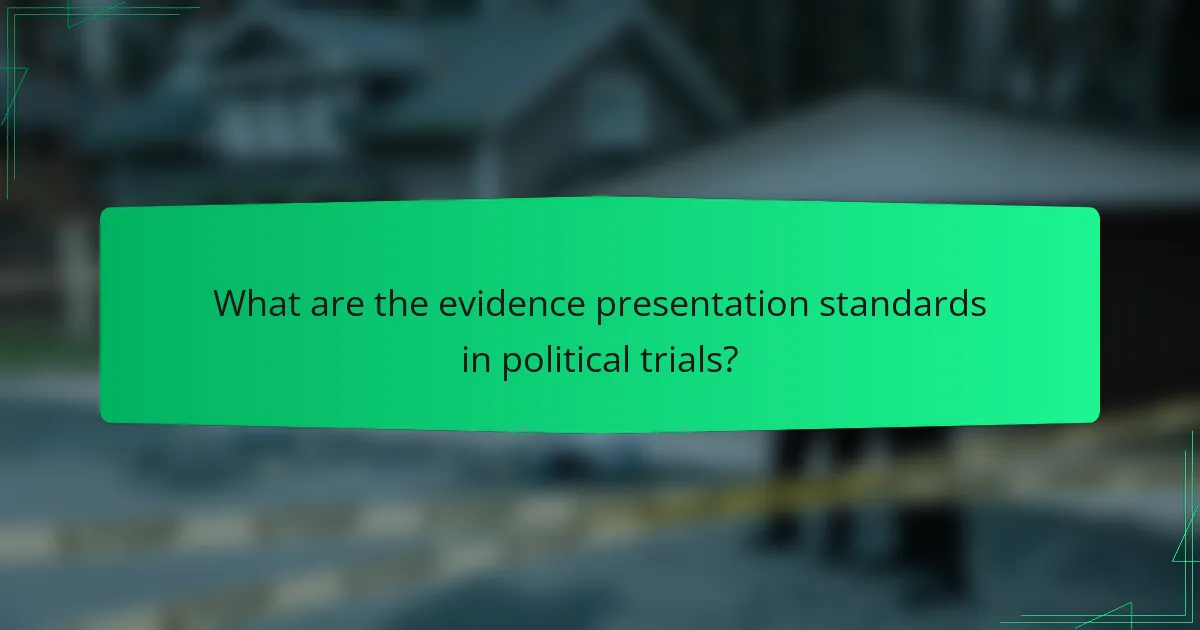
What are the evidence presentation standards in political trials?
Evidence presentation standards in political trials require that all evidence be relevant, admissible, and reliable. Relevance means the evidence must pertain directly to the case at hand. Admissibility refers to whether the evidence can be legally presented in court. Reliability ensures that the evidence is credible and trustworthy.
These standards are often guided by established legal frameworks and precedents. For instance, the Federal Rules of Evidence in the United States outline specific criteria for evidence evaluation. Courts assess evidence based on its probative value versus potential prejudicial impact.
In political trials, the scrutiny of evidence is heightened due to the public interest involved. Historical cases, such as impeachment trials, demonstrate the critical nature of adhering to these standards. The integrity of the judicial process relies on maintaining these rigorous evidence presentation standards.
How have these standards evolved over time?
Evidence presentation standards in political trials have evolved significantly over time. Initially, these standards were informal and varied greatly by jurisdiction. In the early 20th century, formal guidelines began to emerge, influenced by legal reforms and the need for consistency. The introduction of the Federal Rules of Evidence in 1975 marked a pivotal moment, establishing uniform procedures for evidence presentation in federal courts.
Since then, advancements in technology have further transformed these standards. The rise of digital evidence has necessitated new protocols for handling and presenting such materials. Recent trends emphasize transparency and accessibility, reflecting a growing demand for public trust in the judicial process.
Additionally, international human rights standards have influenced domestic practices, advocating for fair trials and the right to a defense. As a result, contemporary standards now prioritize not only the integrity of evidence but also the rights of individuals involved in political trials.
What historical events influenced the development of these standards?
The development of evidence presentation standards in political trials has been influenced by several historical events. The Nuremberg Trials after World War II established precedents for international law and evidence handling. The Civil Rights Movement in the 1960s highlighted the need for fair trials and transparency in evidence presentation. The Watergate scandal in the 1970s emphasized the importance of accountability and integrity in political trials. Additionally, the rise of technology has shaped the way evidence is collected and presented in modern courts. These events collectively contributed to evolving standards that prioritize fairness and clarity in political trial proceedings.
How did legal precedents shape current evidence presentation practices?
Legal precedents significantly influenced current evidence presentation practices. Historical cases established guidelines for admissibility and relevance of evidence. For instance, the Frye Standard from Frye v. United States (1923) required scientific evidence to gain general acceptance in its field. This standard laid the groundwork for evaluating expert testimony. Later, the Daubert Standard from Daubert v. Merrell Dow Pharmaceuticals (1993) further refined criteria for scientific evidence. It emphasized reliability and relevance, shaping how courts assess expert opinions. These precedents created a structured framework that courts follow today. They ensure that evidence presented is both pertinent and scientifically valid. Thus, legal precedents have been crucial in evolving evidence presentation standards.
Why are evidence presentation standards important in political trials?
Evidence presentation standards are crucial in political trials to ensure fairness and transparency. These standards help maintain the integrity of the judicial process. They provide guidelines for how evidence is collected, presented, and evaluated. Adhering to these standards protects the rights of all parties involved. It minimizes the risk of bias or manipulation of information. Furthermore, they enhance public confidence in the legal system. Historical cases, such as the Watergate scandal, illustrate the impact of evidence standards on political accountability. Inadequate standards can lead to unjust outcomes and erode trust in governance. Thus, evidence presentation standards are foundational for upholding justice in political trials.
What role do these standards play in ensuring fair trials?
Standards play a crucial role in ensuring fair trials by establishing consistent guidelines for evidence presentation. These standards help maintain the integrity of the judicial process. They promote transparency and accountability within the legal system. By defining acceptable methods for presenting evidence, they protect against bias and misinformation. Historical examples show that adherence to these standards has led to more equitable outcomes in trials. For instance, the adoption of the Federal Rules of Evidence in the U.S. has improved the reliability of evidence. This, in turn, enhances public confidence in the justice system. Overall, these standards are essential for upholding the principles of justice and fairness in legal proceedings.
How do they impact public perception of the political justice system?
They significantly shape public perception of the political justice system. Media coverage influences how citizens view fairness and transparency. High-profile trials often lead to heightened scrutiny of judicial processes. Perceptions can shift based on the portrayal of evidence and arguments in these cases. Public trust may wane if inconsistencies or biases are perceived. Historical examples show that sensationalized trials can lead to widespread skepticism. For instance, the O.J. Simpson trial in the 1990s altered views on race and justice. Such cases demonstrate the profound impact of evidence presentation on societal beliefs.
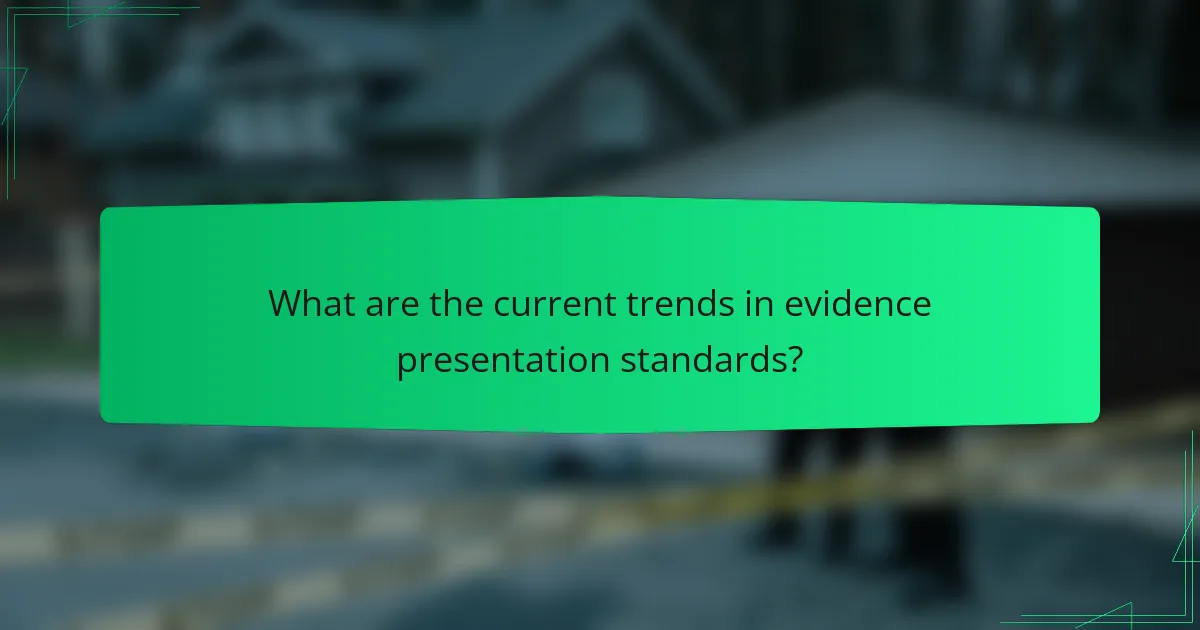
What are the current trends in evidence presentation standards?
Current trends in evidence presentation standards emphasize clarity, accessibility, and technology integration. There is a growing focus on visual aids to enhance understanding. Multimedia presentations are increasingly utilized to convey complex information. Standardization of formats is being adopted to ensure consistency across trials. Additionally, there is a shift toward more interactive presentations to engage juries effectively. These trends aim to improve the overall comprehension of evidence by diverse audiences. Research indicates that these methods can significantly impact jury decision-making processes. Studies show that juries respond better to organized and visually appealing evidence presentations.
How are technology and digital evidence changing presentation standards?
Technology and digital evidence are significantly changing presentation standards in political trials. The integration of digital tools enhances the clarity and accessibility of evidence. Visual aids like videos and infographics make complex information easier to understand. Digital platforms allow for real-time sharing and collaboration among legal teams. This shift promotes transparency and accountability in the judicial process. According to a study by the National Center for State Courts, 75% of judges believe that technology improves the presentation of evidence. Additionally, digital evidence can be easily archived and retrieved, ensuring that it is accessible for future reference. The evolution of these standards reflects a broader trend towards modernization in the legal field.
What types of digital evidence are increasingly used in political trials?
Types of digital evidence increasingly used in political trials include social media posts, emails, and text messages. Social media posts often provide real-time insights into public opinion and communications. Emails can reveal correspondence between officials or parties involved. Text messages serve as direct communication evidence, often showing intent or conspiracy. Additionally, video and audio recordings are utilized to capture events or statements. These forms of digital evidence are critical for establishing context and credibility in political trials. Their prevalence reflects the growing reliance on technology in legal proceedings.
How do courts address challenges related to digital evidence?
Courts address challenges related to digital evidence through established legal standards and procedures. They evaluate the admissibility of digital evidence based on relevance, reliability, and authenticity. Courts often require that digital evidence be properly preserved and collected to avoid contamination. They may also consider expert testimony to explain the technical aspects of digital evidence. The Federal Rules of Evidence provide guidelines for handling electronic records. Courts assess the integrity of the data to ensure it has not been altered. Case law illustrates how courts have ruled on issues regarding digital evidence, such as in United States v. Chen, where the court emphasized the importance of a proper chain of custody. These measures help ensure that digital evidence is treated with the same scrutiny as traditional forms of evidence.
What are the implications of recent changes in evidence presentation standards?
Recent changes in evidence presentation standards impact the clarity and effectiveness of trials. These changes aim to enhance the understanding of evidence by juries. Improved standards help reduce ambiguity in how evidence is interpreted. They also promote the use of technology, such as digital presentations, to convey information more effectively.
As a result, the likelihood of misinterpretation decreases. This can lead to fairer outcomes in political trials. Furthermore, standardized procedures for evidence presentation increase consistency across different cases. Legal professionals are now better equipped to present complex information clearly. These implications collectively contribute to a more transparent judicial process.
How do these changes affect the prosecution and defense strategies?
Changes in evidence presentation standards significantly impact prosecution and defense strategies. Prosecution may adjust its approach to emphasize more visual and accessible evidence. This shift can enhance jury engagement and comprehension. Additionally, stricter standards may require prosecutors to strengthen the admissibility of evidence.
Defense strategies might evolve to focus on challenging the credibility of new evidence formats. Defense attorneys may also leverage these changes to argue for more stringent scrutiny of evidence. The emphasis on transparency can lead to increased opportunities for defense teams to scrutinize prosecution evidence.
Overall, these changes necessitate both sides to adapt their strategies to align with evolving standards. Adapting to these changes is crucial for effective representation in political trials.
What are the potential risks associated with evolving standards?
Evolving standards can lead to several risks, including inconsistencies in legal interpretations. These inconsistencies may arise when different jurisdictions adopt varying standards. This can create confusion for legal practitioners and defendants alike. Furthermore, evolving standards may outpace the understanding of evidence presentation among legal professionals. This gap can result in improper handling of evidence during trials. Additionally, rapid changes can lead to a lack of public trust in the judicial system. When standards change frequently, the perception of fairness may be compromised. Lastly, there is a risk of increased litigation as parties dispute the applicability of new standards. Historical cases show that unclear standards have led to prolonged legal battles and appeals.

What does the future hold for evidence presentation standards in political trials?
The future of evidence presentation standards in political trials is likely to emphasize digital and multimedia formats. Increasing reliance on technology will shape how evidence is displayed and interpreted. Virtual reality and augmented reality may become integral in presenting complex evidence. Enhanced data visualization techniques will improve clarity and engagement for jurors. Additionally, legal frameworks will adapt to address challenges posed by digital evidence. Cybersecurity measures will be crucial to ensure the integrity of evidence. As public scrutiny rises, transparency in evidence presentation will become more critical. Overall, these trends indicate a shift towards more dynamic and accessible evidence presentation methods in political trials.
What emerging trends may shape future standards?
Emerging trends that may shape future standards in evidence presentation for political trials include advancements in technology, increased focus on transparency, and evolving public expectations. Technology such as artificial intelligence and virtual reality is transforming how evidence is presented and perceived. Enhanced digital tools improve the clarity and accessibility of evidence for juries and judges. Transparency in legal processes is becoming essential, as public scrutiny grows. This shift demands clearer communication of evidence and its implications. Additionally, public expectations for fairness and impartiality are rising. These expectations influence legal standards and practices. The combination of these trends is likely to redefine how evidence is presented in political trials, ensuring it meets contemporary societal demands.
How might artificial intelligence influence evidence presentation?
Artificial intelligence might influence evidence presentation by enhancing data analysis and visualization. AI can process vast amounts of data quickly, identifying patterns that humans may overlook. This capability allows for more accurate and efficient evidence evaluation. Additionally, AI can create compelling visual representations of evidence, making complex information more accessible. For instance, AI-driven tools can generate infographics that summarize key evidence points. Research indicates that AI can improve the clarity of presented evidence, leading to better understanding among jurors. In political trials, this can ensure that critical information is communicated effectively.
What role will public opinion play in future standards development?
Public opinion will significantly influence future standards development in political trials. As societal values evolve, public sentiment shapes the expectations for transparency and accountability. Stakeholders in the legal and political arenas increasingly consider public opinion when establishing standards. For instance, recent movements advocating for justice reform demonstrate the power of public advocacy. Research shows that standards reflecting public concerns can enhance legitimacy and trust in legal processes. Historical examples, such as the impact of civil rights movements, illustrate how public opinion led to changes in legal standards. Therefore, public opinion will continue to be a critical factor in shaping the future of standards development in political trials.
What best practices should be adopted for effective evidence presentation?
Effective evidence presentation requires clarity, organization, and relevance. Clear visuals enhance understanding and retention. Organizing evidence logically aids in comprehension. Relevant evidence directly supports claims and arguments. Using credible sources strengthens the argument’s validity. Engaging storytelling can make data more relatable. Consistent formatting ensures professionalism and readability. Finally, practicing delivery improves confidence and impact.
How can legal professionals prepare for changes in evidence standards?
Legal professionals can prepare for changes in evidence standards by staying informed about legislative updates and judicial rulings. Regularly attending legal seminars and workshops can enhance their understanding. Engaging with professional organizations provides access to resources and networking opportunities. Reviewing case law helps identify trends and shifts in evidence requirements. Collaborating with peers can facilitate the sharing of best practices. Utilizing legal research tools aids in tracking evolving standards. Adapting legal strategies proactively ensures compliance with new evidence protocols. Continuous education and training are essential for maintaining competency in this dynamic field.
What resources are available for staying updated on evidence presentation trends?
Resources for staying updated on evidence presentation trends include academic journals, professional organizations, and online platforms. Academic journals such as the Journal of Evidence-Based Legal Studies publish peer-reviewed articles on the latest findings. Professional organizations like the American Bar Association offer webinars and publications focused on best practices. Online platforms, including legal blogs and websites, provide timely updates and discussions on emerging trends. Additionally, conferences and workshops facilitate networking and knowledge sharing among practitioners. These resources ensure that legal professionals remain informed about advancements in evidence presentation standards.
The main entity of the article is “evidence presentation standards in political trials.” This article provides a comprehensive overview of the evolution of these standards, highlighting their historical context, current trends, and future directions. It discusses the importance of relevance, admissibility, and reliability in evidence, as well as the influence of legal precedents and historical events on contemporary practices. The article also examines the impact of technology and digital evidence on presentation standards, emerging trends, and best practices for legal professionals to adapt to ongoing changes in the judicial landscape.
